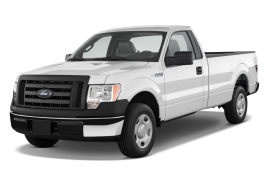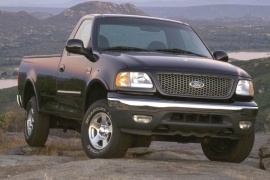
FORD F-150 Regular Cab
Generations Timeline, Specs and Pictures

The best selling vehicle in the U.S., after 34 years in a row is the Ford F150. In the half-ton pickup, the F-150 is the all-around vehicle, from the hard-working truck to the car for a date.
The secret of the F-150’s success is Ford’s refusal to rest on its glory. In 2011, the company refreshed the F150’s engine and transmission to include a twin-turbocharged V6. The half-ton truck received more improvements in interior comfort and off-road ability. For instance, the rear axle received a locking differential instead of the limited-slip type as it was used before. A new feature was added for the Hill Start Assist, which was offered as an option before but since 2012 it became standard. A new two-speed automatic 4x4 system was added from the Lariat trim levels and up.
The 2012 F-150 was offered in three body variants: regular cab, SuperCab, and SuperCrew. The Regular Cab features a front-facing rear smaller door that provides access behind the seats. Either if there is a bench-seat or bucket-seats, there is some storage space in the back. That space it is great for a toolbox. Or a shotgun, whatever works.
Between the dials on the instrument cluster, a new 4.2” display showed information for the on-board computer, fuel economy, range, average speed or information about the 4x4 system, if fitted. There are 10 trim levels on the F-150, and apart from the base, XT model, Ford offers the SYNC infotainment system that supported iPod connectivity, Bluetooth connectivity with the mobile phone.

Despite the world financial crisis, the F-150 remained on top of the customers’ preferences, and the carmaker introduced a new model in 2009.
Ford showcased the F-150 at the 2008 North American International Motor Show. While the U.S. economy crumbled due to the financial crisis, Ford marched with its best-selling product of all times. Its hopes were high, and the twelfth F-150 generation had to pull them out from troubles (some Government money helped too).
The vehicle finally entered the assembly line in October 2008 as a 2009 model year. Ford built it in a few body versions, starting with the Regular-Cab option. It was the contractor’s workhorse, and its short cabin allowed only two doors and a thick B-pillar behind them. The carmaker offered it with either a bare-chassis or with a choice of beds. If the most extended version was not enough, the carmaker added a clever system that allowed the load to be kept safe with the tailgate open. Ford built the pickup for truckers and made a new chassis for the F-150, which was lighter and stronger than the one fitted under the eleventh series.
With the Regular-cab, Ford aimed at those who used the pickup mostly, or only, for work. Its cabin was available with either two seats or a bench seat with seating for three. The XL (base) version featured a radio, AC, and cranked windows, while the highest trim level provided the comfort needed by company owners.
Under the hood, Ford installed a choice of three V-8 engines for the Regular-Cab version, with an option for either rear or 4x4 systems.

The eleventh generation of the most sold vehicle worldwide, the F150 series, was introduced in 2003 as a 2004 model year.
The Ford F-150 represents one of the most important vehicles in the American carmaker lineup. By 2003, it was evident that it had to keep its standards and continuously improved the most notorious pickup-truck. Along with the new generation, Ford introduced some stylistic changes that made the vehicle unique on the market.
For the regular-cab version, Ford installed a small window behind the doors, like an extended-cab model. The dipped-down front side of the door-windows, like the Ford Super Duty series. The carmaker offered the F150 with a regular or extended bed. The former was mostly used for off-road enthusiasts. In the 4x4 version, the F150 sported closed-loop tow hooks at the front.
Inside, there was a car-like interior, with a wide center stalk and silver trims. The wide center console featured cup-holders good enough for a big-gulp pop can. Ford re-arranged the dials on the instrument cluster and placed the small gauges for fuel-level, coolant-temperature, ammeter, and oil pressure between the big speedometer and tachometer. All versions sported a floor-mounted gear selector for the automatic transmission.
Under the hood, Ford installed a choice of three gasoline engines that provided between 202 hp and 300 hp. It was available with rear- or all-wheel-drive.

Ford introduced the tenth generation of its F-150 pickup in 1996 and showed a departure from its predecessor’s boxy-style design.
The F-150 series was the best-selling vehicle in the world, and Ford had to improve it to keep up with its competitors, who tried to steal its crown. For that, the blue-oval brand revised the chassis and introduced new engines and transmissions. It was available in a few cabins and bed versions and the shortest one, named Regular Cab, was the true family workhorse.
For the 1997 model, the designers took their time to accomplish a distinctive image for the F150. At the front, the F150 sported a front fascia with rounded edges and a reversed trapezoidal grille. The bumper was body-colored or chrome, depending on the trim level, and sported a pair of fog lamps mounted on the outer side, with an additional narrow air-intake between them. Ford offered the pickup with a choice of two beds in the back, a 6ft5” and an 8ft one (1.98m and 2.43m) and two wheelbases.
Inside, the designers threw away the straight lines from its predecessor and imagined flowing curves and an ovoid-shaped instrument cluster. Depending on the options, the F150 featured two individual seats or a 60/40 split-folding bench with a wide armrest in the middle. The carmaker equipped the pickup with power windows, power door locks, power mirrors, climate control, and a stereo-cassette player on top trim levels.
Under the hood, Ford installed a choice of three engines paired to either a five-speed manual or a four-speed automatic transmission. Power went to the rear or to all four wheels via a transfer case with a low-range gear.























































